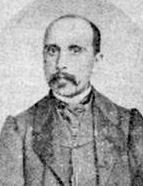

Of bourgeois origin, he was born on 15 June 1823 to José Maria Teixeira de Aragão and Mariana Hermogenes da Silva. He graduated in Medicine from the Lisbon Medical and Surgical School and began his professional career as a Surgeon-Physician in 1849, being promoted to Surgeon-Major in 1853. When he retired in 1896, he held the rank of General. Alongside his military career, Teixeira de Aragão held the positions of Secretary-General of the Government of India and Director of the Numismatic Cabinet of D. Luís I.
Teixeira de Aragão was one of the main figures in Portuguese numismatics, but his work, which ranges from popular to scholarly historiography, was not restricted to this area of knowledge. Teixeira de Aragão was , above all , a scholar influenced by the national historical interpretation of Herculano, whom he called his ‘master’.
In 1850, he began his collection and study of ancient coins, perhaps inspired by the growing prominence that numismatics had achieved in Portugal during the 19 th century, above all due to the positive repercussions of 1801, the date from which the Diploma cy course taught at the University of Coimbra, which was based at the Torre do Tombo, included numismatics in its syllabus. In addition, the Office of Coins and Medals was created at the Torre do Tombo in 1836 , and the number of publications on numismatics was on the rise ( Dicionário de História de Portugal [Dictionary of the History of Portugal] , 1968, vol. III, p.170). Over the years, his collection of coins and medals grew in quantity and quality.
In 1867, he sold some of his valuable coins to D. Luís I and , with this gesture , ‘fell into the good graces of D. Luís’, leaving him in an ‘excellent social position [ … ] as conservator of the Royal Office and friend of the King, which gave him influence and [ … ] placed him in a position where he could engage in fruitful scientific research’ ( Da Numismática em Portugal [Of Numismatics in Portugal] , 1923, pp.157-158). In th at same year, he was sent to Paris by the Ministry of Public Works with the aim of accompanying the royal collections on display in the History of Fine Art s sections of the Universal Exhibition. His stay in this city proved to be very fruitful. His command of French, English , and Spanish allowed him to interact with the great figures of European numismatics, with whom he exchanged correspondence and knowledge.
This work is financed by national funds through FCT - Foundation for Science and Technology, I.P, in the scope of the projects UIDB/04311/2020 and UIDP/04311/2020.
